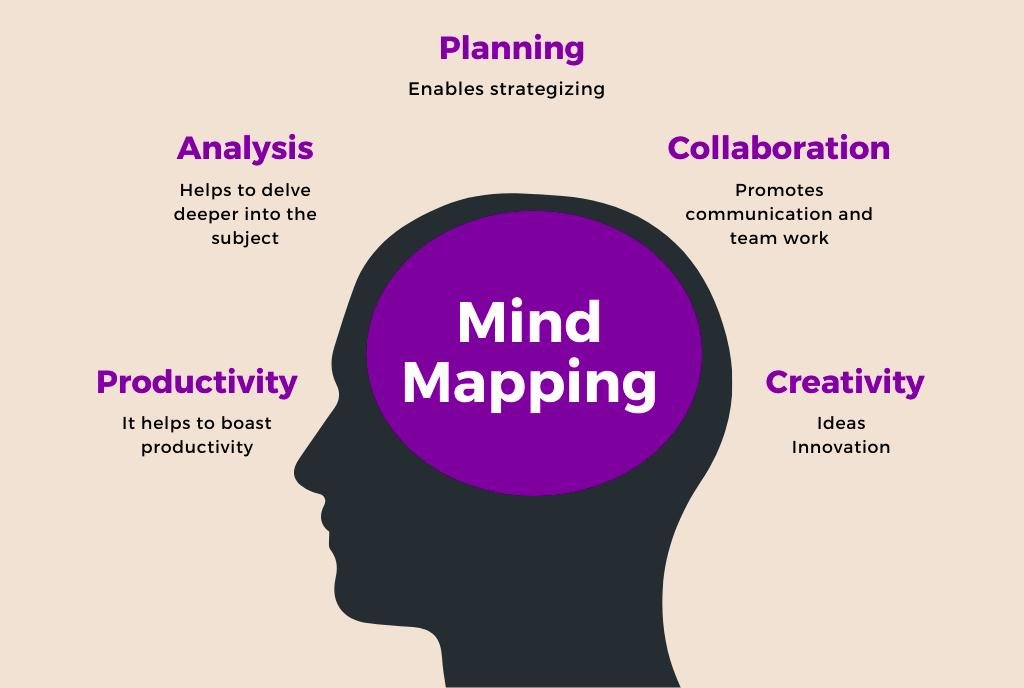Mind Mapping: Visualizing Knowledge for Enhanced Understanding

Discover the power of Mind Mapping for enhanced understanding and improved knowledge retention. Explore how this visual tool can transform your learning experience. Learn about the benefits of mind mapping in education, business, problem-solving, and personal development. Enhance your creativity, productivity, and decision-making skills with this versatile technique. Find out how mind mapping can revolutionize your note-taking and study methods.
In today’s information-rich world, understanding complex concepts and retaining vast amounts of information can be challenging. Fortunately, there are powerful cognitive tools available that can aid in knowledge retention and comprehension. One such tool is “Mind Mapping.” In this article, we will explore the concept of mind mapping, its benefits, and how it can enhance our understanding of various subjects.
Read More: Boost Your Study Skills: Techniques to Improve Learning
What is Mind Mapping?
At its core, a mind map is a visual representation of ideas, concepts, and information. It is a diagram that uses words, images, colors, and connections to depict the relationships between different pieces of information. Mind maps mimic the way our brains naturally organize and process information, making them an effective and efficient tool for learning and problem-solving.
The Elements of a Mind Map
A mind map typically consists of the following elements:
Central Idea or Topic: Positioned at the center of the map, this is the main subject or theme that you want to explore.
Branches: Radiating out from the central idea, branches represent the main categories or sub-topics related to the central theme.
Keywords: Each branch contains keywords or short phrases that capture the key points associated with that category.
Images and Icons: Mind maps often incorporate images and icons to make the map more visually engaging and memorable.
Colors: Colors are used to distinguish different branches and elements, aiding in better retention and recall.
The Process of Mind Mapping
Creating a mind map is a straightforward process that can be done both on paper and digitally with various mind-mapping software. Here’s a step-by-step guide on how to create a mind map:
Step 1: Start with the Central Idea
Begin by identifying the central idea or topic you want to explore. Write it down in the center of the page or canvas.
Step 2: Add Main Branches
Next, think of the main categories or sub-topics related to the central idea. Draw branches radiating from the central idea and label each branch with a keyword representing that category.
Step 3: Add Sub-Branches and Keywords
For each main branch, add sub-branches to further expand on the topic. Include relevant keywords or short phrases on these sub-branches.
Step 4: Use Images and Colors
Enhance your mind map by incorporating images and using colors to differentiate between branches. Visual elements make the mind map more stimulating and memorable.
Step 5: Make Connections
Draw connections between related branches and ideas. This visual representation of connections helps in understanding the relationships between different concepts.
Step 6: Review and Refine
Take a moment to review your mind map. Ensure that the information is logically organized and that the connections accurately represent the relationships between ideas.
The Benefits of Mind Mapping
Mind mapping offers a wide range of benefits that can significantly improve learning, problem-solving, and memory retention. Some of the key advantages include:
Enhanced Understanding
Mind mapping helps individuals grasp complex concepts more easily by presenting information in a visual and interconnected manner.
Improved Memory Retention
The visual and associative nature of mind maps enhances memory retention, making it easier to recall information later.
Creative Thinking
Mind maps encourage creative thinking and the generation of new ideas, as they provide a flexible and non-linear structure for organizing thoughts.
Effective Note-Taking
Mind mapping is a powerful note-taking method that allows students and professionals to summarize lectures, books, or meetings in a visually organized format.
Efficient Problem Solving
Mind maps enable individuals to break down complex problems into smaller components, making problem-solving more efficient and systematic.
Applications of Mind Mapping
Mind mapping finds applications in various aspects of life, including:
Education
Mind maps are widely used in the field of education to help students understand complex topics, organize information, and study more effectively. Students can create mind maps to summarize lessons, make connections between different concepts, and enhance their overall learning experience.
Business
In the corporate world, mind mapping is employed for various purposes. It aids in strategic planning, brainstorming sessions, project management, and organizing ideas during meetings. Teams can collaborate on mind maps to visualize workflows and identify potential opportunities and challenges.
Problem Solving
Mind mapping is a valuable tool for tackling problems and finding innovative solutions. By breaking down complex issues into smaller components and visualizing the relationships between them, individuals and teams can approach problem-solving in a more systematic and efficient manner.
Personal Development
Individuals use mind maps for personal development and goal setting. They can map out their aspirations, identify steps to achieve them and monitor progress along the way. Mind maps also help in identifying strengths and weaknesses, fostering self-awareness and personal growth.
Note-taking and Study Aids
Mind maps serve as excellent study aids. Students can create visual summaries of course material, making it easier to review and retain information. Mind maps can also be used to organize notes from lectures, textbooks, and research materials.
Creative Projects
Artists, writers, and designers utilize mind maps to stimulate creativity and organize their ideas. When working on creative projects, a mind map provides a flexible structure to explore different possibilities and generate new concepts.
Decision Making
Mind mapping aids in decision-making processes by weighing pros and cons, exploring potential outcomes, and visualizing the consequences of different choices. It facilitates a more comprehensive understanding of complex decisions.
Project Planning
Mind maps are valuable for project planning, as they allow project managers and teams to outline project goals, tasks, deadlines, and dependencies. It helps ensure that everyone involved is on the same page and contributes to a successful project outcome.
Read More: The Benefits of Physical Exercise for Cognitive Performance
Conclusion
Mind mapping is a versatile and powerful technique for visualizing knowledge and enhancing understanding. By leveraging its benefits, individuals can unlock their full cognitive potential and navigate complex information with ease. Whether you’re a student, a professional, or someone seeking to improve personal development, mind mapping is a valuable skill to adopt. Embrace the power of mind mapping, and you’ll find yourself better equipped to comprehend, retain, and apply knowledge in various areas of life.
FAQs
Q1: Can children use mind-mapping techniques?
Absolutely! Mind mapping is a user-friendly technique that can be adapted for children of all ages to improve their learning and creative abilities.
Q2: Is it necessary to use mind mapping software, or can I create mind maps on paper?
You can create mind maps using traditional pen and paper, but mind mapping software offers additional features and convenience.
Q3: Can mind mapping help with time management?
Yes, mind mapping can aid in time management by organizing tasks and setting priorities in a visual and structured way.
Q4: Are there any famous personalities who use mind mapping?
Yes, several notable individuals, including Tony Buzan and Leonardo da Vinci, have been advocates of mind mapping for enhancing creativity and productivity.
Q5: How long does it take to become proficient in mind mapping?
The learning curve for mind mapping is relatively short. With practice, you can become proficient in creating effective mind maps in a matter of days or weeks.







